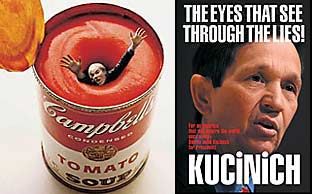DESIGNISM: Instigating Social Change
Designism: Instigating Social Change, was a panel discussion organized by the famed Art Directors Club of New York City, and presented as a forum that would focus on the “role and responsibility of creatives to instigate social change”. Naturally, as an artist long committed to a socially engaged art, the forum sounded interesting, but living and working in L.A. made attending the panel discussion more than a little difficult. Fortunately, the Art Directors Club released the proceedings as an audio podcast, and it’s well worth the time to listen to the hour and a half long discussion. Unfortunately, some of the panelists got a bit excited during their presentations and resorted to profane language, so the pod cast may not be suitable for a younger audience. [ listen to the pod cast ]
Held at the ADC’s facilities on September 21st, 2006, the event was brought about by ADC vice-president Brian Collins, who invited a stellar group of artists, designers, and writers to talk about how “today’s design and advertising professionals can use their skills and talents to shape life and instigate social change in our challenging times.” It was quite a significant forum, and the fact that design professionals working in the corporate advertising environment are thinking and organizing along these lines bodes well for the future.
Moderated by Steve Heller, senior art director for The New York Times and author of over seventy books on graphic design (including one of my favorites, Art Against War, which he co-authored with another great designer/illustrator, Seymour Chwast), the panel discussion participants included Tony Hendra, Milton Glaser, George Lois, Kurt Andersen, James Victore, and Jessica Helfand. Hendra opened the panel with some brilliant observations on the role images play in the advancement of humanity, and his closing remarks drove home the themes and purposes of the forum;
“We are living in a time, it seems to me, not just of religious fundamentalism, Islamic or Christian, but fundamentalism about social policy, fundamentalism about the market, about science, art, knowledge itself, about what it means to be human and humane – about what it means to be an American. And the thing about fundamentalists is, one must always remember – they want to change things fundamentally. So it’s also a time of outrage, fear, violent passions – it’s as if we are in kind of a bloodless civil war. But for some reason, and it may be just the old fart in me talking, I don’t see these extremes of feelings and thought mirrored in the images and designs of the visual vocabulary of my day to day environment. (….) Is it true that design in a general sense, is not reflecting the great passions of our time? Is there a hunger for a revolution, or perhaps reenergizing would be a better word – of design? Is it worth organizing that energy into a group, a movement?”

Hearing Milton Glaser address the issues at hand was a real delight. A godfather of modern-day American design, Glaser counts among his vast credits having created the omnipresent “I (heart) NY” logo. It was Glaser who coined the term “Designism”, the name for a concept he hopes will catch on like wildfire. Simply put, Designism is contemporary design put to social rather than commercial purposes. Glaser and the other panelists discuss this at length on the podcast, and they encourage professional artists to join their Designist movement through the Art Directors Club website.

Another panelist I enjoyed listening to was George Lois – a living legend in the world of advertising design. In the 1960s he created dozens of eye-popping covers for Esquire magazine that captured the very essence of that turbulent decade. He came up with the “I Want My MTV” slogan and helped make Tommy Hilfiger, USA Today, Lean Cuisine, and Jiffy Lube household names through his inspired advertising campaigns. He’s now a signatory to, and passionate advocate of, The World Can’t Wait: Drive Out the Bush Regime. Remember that next time you see one of his ad campaigns on television.

Jessica Helfand, author, designer, and principal of Winterhouse Studios (which publishes books on design and cultural criticism), also had some interesting things to say. I particularly appreciated her espousal of writing as a means of reaching a mass audience and affecting social change. All of the panelists brought something profound and exciting to the table, beseeching the listening audience to have the courage to speak up, and calling upon artists to use their skills to help bring about a better world – undertakings I fully endorse in our troubled times.


